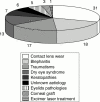Bacterial keratitis: a prospective clinical and microbiological study
- PMID: 11423460
- PMCID: PMC1724042
- DOI: 10.1136/bjo.85.7.842
Bacterial keratitis: a prospective clinical and microbiological study
Abstract
Aim: To define the clinical and microbiological profile of bacterial keratitis at the Jules Gonin Eye Hospital and to test the in vitro bacterial resistance.
Methods: Patients presenting with bacterial keratitis were prospectively followed; clinical features (age, risk factors, visual acuity) and response to therapy were analysed. Bacteriological profile was determined and the sensitivity/resistance of isolated strains were tested towards 12 ocular antibiotics (NCCLS disc diffusion test).
Results: 85 consecutive patients (mean age 44.3 (SD 20.7) years) were prospectively enrolled from 1 March 1997 to 30 November 1998. The following risk factors were identified: contact lens wear, 36%; blepharitis, 21%; trauma, 20%; xerophthalmia, 15%; keratopathies, 8%; and eyelid abnormalities, 6%. The most commonly isolated bacteria were Staphylococcus epidermidis, 40%; Staphylococcus aureus, 22%; Streptococcus pneumoniae, 8%; others Streptococcus species, 5%; Pseudomonas, 9%; Moraxella and Serratia marcescens, 5% each; Bacillus, Corynebacterium, Alcaligenes xyloxidans, Morganella morganii, and Haemophilus influenza, 1% each. 1-15% of strains were resistant to fluoroquinolones, 13-22% to aminoglycosides, 37% to cefazolin, 18% to chloramphenicol, 54% to polymyxin B, 51% to fusidic acid, and 45% to bacitracin. Five of the 85 patients (5.8%) had a poor clinical outcome with a visual loss of one or more lines of visual acuity.
Conclusion: Fluoroquinolones appear to be the therapy of choice for bacterial keratitis, but, based upon these in vitro studies, some strains may be resistant.
Figures




References
Publication types
MeSH terms
Substances
LinkOut - more resources
Full Text Sources
Other Literature Sources
Medical
